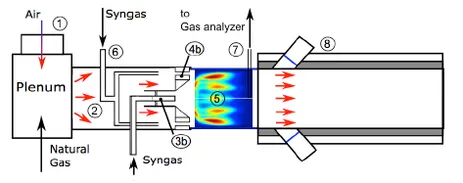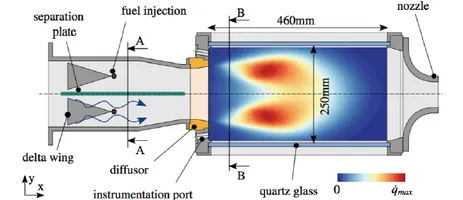High Frequency Combustion Instabilities by Premixed Jet Flames
Supervisor | Subject |
|---|---|
| Prof. Dr.-Ing. Thomas Sattelmayer | Thermoacoustic instabilities, acoustic liners, modeling |
Editor | Cooperation/Funding |
| Rosenkranz, Jan-Andre; M.Sc., Gitau, Stephen | Siemens |
Motivation and Objectives
The progress in gas turbine efficiency in the last decades has led to a steep increase in combustion temperatures which will continue in the future. High combustion temperatures in combination with high residence times lead to an increase in thermal NOx emissions. Therefor new combustion concepts are to be found, because the commonly used swirl stabilized flames in gas turbines are no longer applicable due to high residence times. One innovative, low emission combustion concept is the arrangement of several premixed, turbulent jet flames symmetrically oriented around a center. Previous studies at the Chair of Thermodynamics mainly focused on fuel flexibility and emissions, but there is still a lack of knowledge about flame stability of this innovative concept. Especially instabilities in the high frequency regime are not examined under gas turbine conditions for multiple, turbulent jet flames and there is limited knowledge about the driving and damping mechanisms.
Project Goals
This project aims for deeper insight into the driving mechanisms of high frequency thermoacoustic instabilities of multiple, turbulent jet flames. Previous research mainly focused on high frequency instabilities of swirl stabilized flames that are located at the center of a cylindrical combustion chamber, where the driving mechanisms can be modelled by flame displacement and flame distortion, thus local phenomena. In contrast to that, recent research on high frequency instabilities of multiple, premixed jet flames show a significant injector coupling of the flame dynamics. Therefore, the goal of the project is to identify in which extent different coupling mechanisms contribute to the driving potential of the high frequency instability especially regarding injector coupling, vortex shedding as well as flame displacement and flame distortion. The ultimate goal is to provide a model which covers the convective effects of injector coupling and vortex shedding.
Experimental Setup
The experimental approach is divided into two different combustion test rigs. The first test rig is the HTTC (High Frequency Transverse Mode Tubular Combustor) in which multiple, turbulent jet flames are symmetrically located in the cylindrical combustion chamber. The test rig was designed and used in previous studies at the Chair of Thermodynamics on high frequency instabilities of swirl flames and for the investigation of fuel flexibility [1] of the desired jet flame arrangement using synthesis gas, as shown in Fig. 1. This configuration is designed in similarity to industrial applications with a pilot swirl burner in the center for flame stabilization.
The other test rig is the HTRC (High Frequency Transverse Mode Reheat Combustor) which consists of two stages. The rectangular, second stage shown in Fig. 2 of the HTRC test rig is designed to exhibit self-excited high frequency transverse modes. Previous work [2] focused on a single jet flame in the second stage without injector coupling where acoustically induced vortex shedding was observed. The current project will focus on two turbulent jet flames, which are located at the top and the bottom of the chamber to investigate the driving potential of injector coupling and vortex shedding in more detail.
In both cases the flame dynamics are investigated via simultaneous measurements of pressure fluctuations and OH*-chemiluminescence to gain a further insight into the coupling of heat release and pressure fluctuations.
References
[1] Baumgärtner, M.H.; Sattelmayer, T.: Experimental Study on Low Load Operation Range Extension by Autothermal On-Board Syngas Generation. Journal of Engineering for Gas Turbines and Power 141 (1), 2019
[2] F. Berger et al, A Novel Reheat Combustor Experiment for the Analysis of High- Frequency Flame Dynamics - Concept and Experimental Validation, ASME Turbo Expo 2018, Oslo, Norway 2018.

